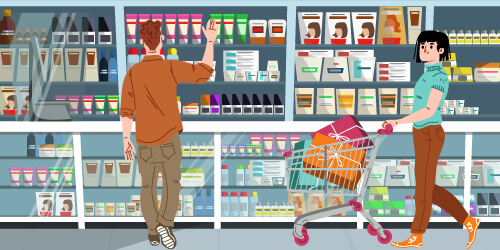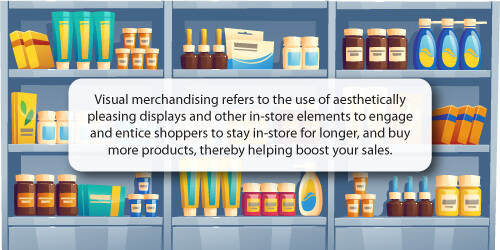The legend goes that when department store Marshall Field's shifted from wholesale to retail, they needed to find a way to attract shoppers. Their answer was to create a visual display. And, in so doing, visual merchandising was born*. While it began as an art, it has evolved to become a science and a critical tool for business promotion.
That's not to say that the principles have changed. While it has become more sophisticated, the fundamentals remain the same.
There is also the point that it can go a long way to allowing you to build your reputation as a retailer. Given its importance to your brand and store, you need to know how to make the most of it.

Create window displays that pull customers into your store
As much as you might not like to admit it, customers will judge your store based on its window display. Get it right, and you'll have customers streaming in, intrigued by what they see. Get it wrong, however, and you can expect the opposite. Customers will take one look and walk past.
So how do you go about building window displays that pull customers into your store? Simple: you ask yourself a series of questions. To be more specific, you ask questions that begin with what, when, where, and why and answer them in detail.
Let us explain each question:
What?
The 'What' refers to the product you'll place in your store.
Looking at the current trends within your market, what product would be best suited to be displayed in-store right now? It doesn't matter if you're selling clothing, sports equipment, appliances or something else. What product would entice customers to walk into your store to find out more?
When?
The 'When' requires you to look at the seasonality of your items.
There is no point in placing a winter product on display in the middle of summer. Of course, it will differ if you sell non-seasonal products. In that case, it's best to consider your market trends and design an appropriate display.
Where?
The 'Where' refers to the position of your product within the display.
Where you position a product will impact how your customers view the item. For example, you could inadvertently put the focus on a product when in fact, you're attempting to highlight an item that is beside it.
That said, be careful not to overcrowd your window with items. The last thing you'd want is a cluttered display that lacks clarity or focus.
Why?
The 'Why' question is straightforward.
Why are you placing a product in the window? Is it because it's part of a new line? Is it because you're running a promotion? Or are you placing it in the window to increase its exposure?

Choose retail displays that attract the right attention
As far as visual merchandising tips go, the most obvious advice is this: choose a retail display that shows off your products the best.
That sounds simple enough, and it is. After all, this is about presenting your products in a way that attracts attention and encourages shoppers to buy.

However, the reality is that many retailers don't consider this. Instead of choosing displays and fixtures that will help them sell their product, they select any display which ends up working against them.
To prevent that from happening in your store, here's how you can pick the right displays for your products:
Consider the products on display
You need to understand the product and why your shoppers buy it.
Let's say, for example, you're an FMCG retailer and have a special on milk this month that you want to highlight. Since this is a product that shoppers buy habitually, you wouldn't need to do too much to draw attention to it. Add clear signage directing your customers to the display and ensure it's in an easy-to-access area.
It's different if you're selling camera equipment or similar products. In that case, you'd be better off creating a display that sells the lifestyle of anyone who uses it. A television on a custom-made stand showing shoppers the adventures people have had with the camera can have them dreaming of what they can do.
Match your displays to your retail brand
If, for example, you're a high-end retailer selling jewellery and clothing, you'd do well to create or choose a display that matches the expectations of any shoppers who enter your store.
While it ultimately doesn't matter what materials you use, the last thing you'd want to do is have a display that cheapens your brand.

Group similar products in-store
When featuring your products in-store, it's not only about the display types you use. While they most definitely play a role in drawing in shoppers, it's also about how you present your products to your customers.
In most cases, success lies in the various visual merchandising principles you use, of which the most well-known is the 'Rule of Three'.
Rule of Three
While used across multiple industries, in retail, this principle declares that shoppers are more visually engaged when they notice grouped items. These items usually complement each other.
For example, if you sell appliances, you could create a display that includes a Kettle, Toaster and Gas Stove. To add extra motivation to buy, you could ensure that they're all of the same brand and colour. That way, they might be tempted to buy more than just one of the items.
More importantly, by grouping these products, you can create a visual display that shows these items in use. Similar to our above point about retail displays, you can establish a connection with your shoppers, showing them what they could expect if they buy the product/s.
It's also worth noting that if you've approached this principle correctly, you can use it to upsell customers. You could even cross-sell products.
Pyramid
Of course, that's not the only principle you could use. Along with the Rule of Three is the Pyramid principle.
It also uses the Rule of Three, but it applies it to a triangular merchandise display.
The item you want to highlight - your focal point - sits at the centre while you'd position smaller complementary items below and to each side.

Use signage that makes it easier to shop in your store
No matter the size of your store or the number of products you sell, it's always a good idea to include signage.
Why? That's simple - it makes for a far easier shopping experience and can even act as a silent salesperson.

Imagine this: a shopper visits your store for the first time, and there is no one around to help them. However, thanks to your clear signage, they know where to find the product they want. Compare that to another scenario. The same shopper walks into your store. There is no one around to help them, and there is no signage to explain where to find anything.
In the first scenario, the shopper will go to the shelf with the product, pick it up and proceed to the checkout counter. They might even shop for longer because the signage you're using makes it easier to find products.
In the second scenario, the shopper might search for a few minutes before giving up and walking out the door. Therein lies the power of proper signage. That said, not all signage has positive results.
Here are a few best practices:
Your signage must be simple and easy to understand
That means not using technical jargon. Let's say you stock nutraceutical products. Not many shoppers will know what that means. You're better off having 'adult multivitamins' on the sign instead.
Your signage must be specific
While simple is always best, it shouldn't be so simple that it's vague. It's not helpful to have an 'Accessories' sign. If you sell kitchenware, for example, it's better to have your sign say 'Baking Accessories' for those items that fall into this section.
Consider a hierarchy in your signage
If your store is large enough and you have multiple departments, use signage to indicate where each section begins. Then, in each department, you can have signage indicating categories and sub-categories.

Don't forget about your atmospherics
The last, but certainly not least visual merchandising tip is to make the most of your atmospherics.
Atmospherics refers to the mood or atmosphere that you purposefully create in-store. It's an attempt to persuade shoppers to spend more time in your store and add products to their baskets while they walk through your store.
Atmospherics includes all five senses: sight, sound, smell, touch and taste.
Sight: This includes the colours you use in your displays and decor.
Sound: This includes the music you play in the background or ambient sounds.
Smell: This includes those scents that entice shoppers into your store and keep them shopping for longer.
Touch/Taste: This can consist of any interactive product demonstration or tasting table set up in-store.
Of course, the above won't all apply to your store.
For example, if you sell electronics, it'll be tough to come up with a scent that entices your shoppers to buy. Meanwhile, if you're a bakery or sell flowers, it's easier.
When choosing what mood you want to set in your store, set it's suited to your target market and the products you offer. Judge your environment and decide what's acceptable to your target market and what's a distraction or irritation. If whatever you do is considered a distraction by your staff or customers, you must reconsider its value.
If you don't know where to begin, ask your customers where you can improve in the form of a survey or poll.

Conclusion
Visual merchandising is a critical part of the picture that is retail success. Remove it, and you won’t be as effective you could hope to be. Of course, you need to implement the above tips correctly to experience success. Thankfully, if you do, you can be confident that you’re in the best possible position to succeed.
Do you need help deciding on how to present your products in your store or what products to stock? Why not book a complimentary consultation with a DotActiv expert here to hear how we can help you with these goals and more? You can also browse our software and service options on our online store here.
*This article was updated on 8 December 2022.



